
Remember that before you multiply big numbers, you should estimate so that you have an idea of what a "reasonable" answer is going to be. That way you know you need to try again if your answer is way off.
This is the regular way to solve multiplication problems with 2 digit times 2 digit numbers. What do you notice about the products in this method, compared the the products you got in the expanded form?
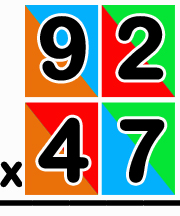
Remember the steps for multiplication by using color!
1. Multiply the green digits.
2. Multiply the blue digits, but remember the 9x7 is actually 90x7.
3. Multiply the red digits, but remember the 4x2 is really 40x2.
4. Multiply the orange digits, but remember the 4x9 is really 40x90.
5. Add all the products for your answer!
Can you solve the other problems using color to help you remember the steps?
37x24 46x39 48x35 56x49 57x43
67x58 73x51 83x74 84x62 94x85

You've now learned the hardest types of numbers that you're going to need to multiply in 4th grade! Great work, everyone! We'll practice more of these types of problems this week before using them in word problems.
Do you remember that starred purple step 3? Remember, if you skip that, you're basically multiplying 40x52 instead of 48x52.
Also, if you forget to multiply all the digits, you'll probably end up with an answer that doesn't have enough digits! Here's another way to look at it. Look at these 3 number sentences:
4 x 5 = 20
40 x 5 =200
40x50=2,000
Which number sentence is the closest estimate to 48x52=2,400?
What do you notice about the number of digits on each side of the equals sign?
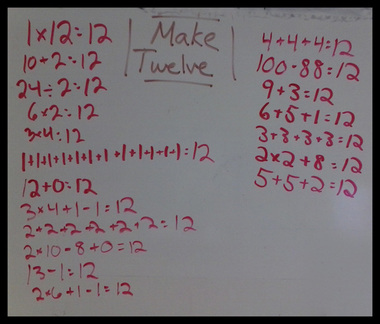
The rules are simple. Add, multiply, subtract, and/or divide, as much as you need to. The challenge: it has to make 12!
How do YOU make 12?

Remember when we did multiplication using expanded form?
We used to write:
300x5=1,500
20x5=100
7x5=35
1,500+100+35=1,635
There is a shortcut, which means a lot less writing! You just need to remember which numbers to multiply, and which number to add.
It's easy to see the 35 in green.
Can you find the 100 in orange? (Hint, 100 = ? tens)
Can you find the 1,500 in red? (Hint, 1,500 = ? hundreds)
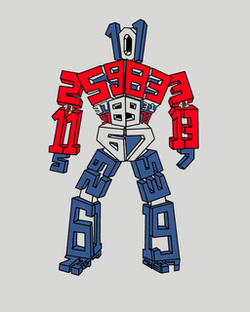
Optimus Prime
Making Factor Rainbows was fun, but prime numbers are cool for all the opposite reasons. They're special because they can't be divided evenly by any number, except of course for itself and 1.
In December, we will work on memorizing all the prime numbers up to 50.
Those numbers are:
2, 3, 5, 7, 11, 13, 17, 19, 23, 29, 31, 41, 43 & 47.
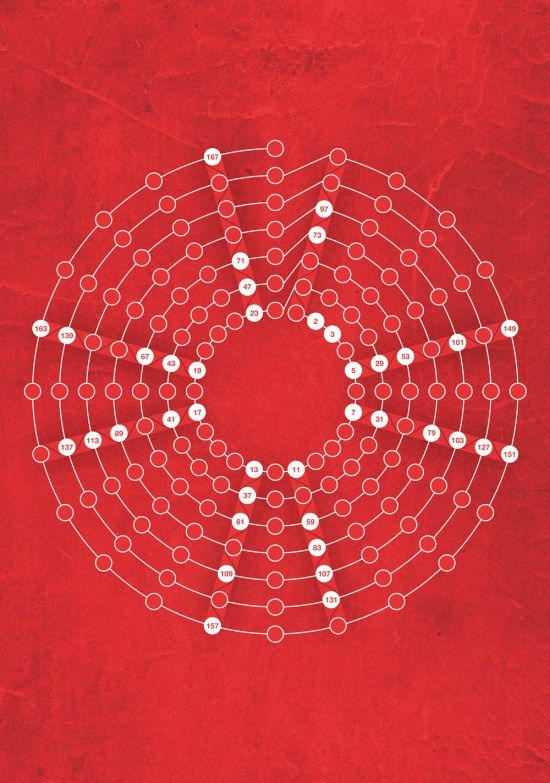
Prime number spiral
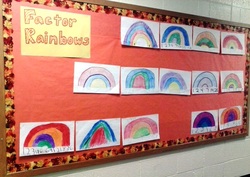
Congratulations to everyone who won the Factor Rainbow competition today!
Your rainbows look great, and show factors in a new way. Instead of listing factor pairs for a number like 24 like this:
(1,24)
(2,12)
(3,8)
(4,6)
You s-p-r-e-a-d them out! Each arch shows the factors that can be multiplied together to get the number you're factoring.
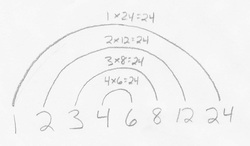
Great work!
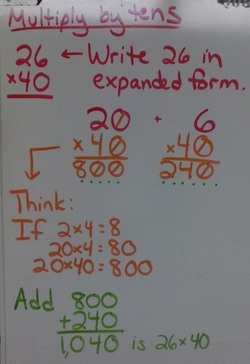
You can multiply without regrouping if you take apart your numbers!
For example, 26 can be broken down into
20 + 6
Earlier this year we called that the expanded form. It's much easier to multiply 20 x 40 and
6 x 40 and then add your products.
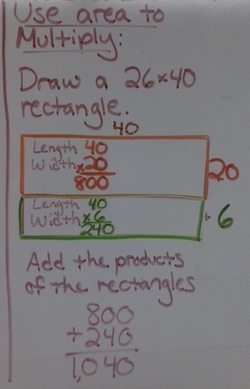
There is another way to imagine breaking apart your numbers. Think of a rectangle that's
40 x 26 feet.
Split that rug into 2 pieces that are:
40 x 20 feet and
40 x 6 feet
If you can find the area of each rug, you can add them together to find the total area.
What's the easiest way for you to multiply
40 x 26?

You already knew that multiplication is just repeated addition. So if you add 78 eleven times, you can get the answer to 78x11.
But that is a LOT of adding!
So here's a shortcut. Instead of adding 78 all those times, just multiply 78 times 10. That's easy. It's 78 with a 0 at the end: 780. Ten 78s equals 780.
Finally, add one more 78 to your answer to get eleven 78s.
780 + 78 = 858.

Today we practiced multiplying with discs instead of pencil and paper. In the example, since you were multiplying 135 x 5, you made 5 piles of each digit.
1. You made 5 piles of 4 blue ones, which equals 20.
2. You made 5 piles of 3 pink tens, which made 15 tens.
3. You made 5 piles of 1 green hundred, which is 5 hundreds.

To complete the problem, you needed to regroup the discs. You know that 10 blue discs is equal to 1 pink ten. You also know that 10 pink tens equals 1 green hundred.
1. First you traded in those 20 blue ones for 2 pink tens.
2. Then you traded 2 pink tens for 2 green hundreds.
The rest is easy! You can see that there are 6 hundreds, seven tens, and 0 ones. So the answer to 134 x 5 = 670.















 RSS Feed
RSS Feed